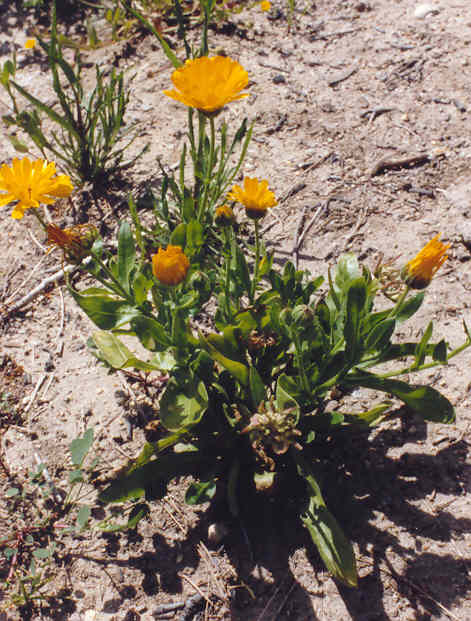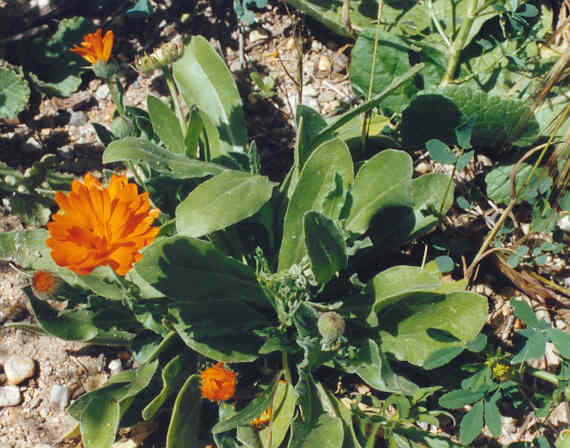
Calendula officinalis L.
Asteraceae (Sunflower Family)
Southern Europe
 |
Calendula officinalis L.Asteraceae (Sunflower Family)Southern Europe
Pot Marigold |
April Photo
Plant Characteristics:
More or less hairy annual 1-2 ft. high; lvs. thickish, oblong to
oblong-obovate, 2-6 in. or more long, entire or minutely and remotely
denticulate, more or less clasping; heads solitary, on stout stalks, showy,
1.5-2 or 4 in. across, the flat spreading rays white-yellow to deep orange,
closing at night, blooming the whole season; sometimes the plant is proliferous
from the involucre, bearing several peduncled heads in a circle; ray-achenes
glabrous, incurved; disk fls. infertile; pappus none.
Habitat:
A common flower garden annual; also grown under glass for winter bloom.
Escape from cultivation in disturbed, urban, coastal areas; below 500 m.
Name:
Latin, calendae or calends, throughout the months.
(Bailey 1016). Officinalis,
officinal, medicinal, recognized in the pharmacopea.
(Bailey 19).
General:
Rare in the study area having been found only in the creek bed at 23rd
St., this in 1993. There were two
plants, the seeds of which, were probably carried down stream from the Cherry
Lake area above. (my comments).
The flower heads of C. officinalis are said to have been used sometimes for flavoring in
cookery. (Bailey 1016).
Calendulas date back to early Roman times and were cultivated in England
before 1573. It was reported that those who partook of marigolds would be
more amorous, see fairies, or be induced to sleep.
(Clarke 243).
Native origin unknown. (Hickman,
Ed. 218). A
salve made from the dried flowers and fresh leaves of C.
officinalis, boiled in lard is a homeopathic remedy for rough, dry or
chapped skin. (Meyer 80 and from
the printing on the tube of salve found at Mother's Kitchen in Costa Mesa,
1995.)
Text Ref:
Bailey 1016; Hickman, Ed.
218; Munz, Flora So. Calif. 132.
Photo Ref:
April 2 93 # 19A, 20A.
Identity: by R. De Ruff, confirmed by John Johnson.
First Found: April 1993.
Computer Ref: Plant Data 449
No plant specimen.
Last edit 11/28/03.
 |
April Photo